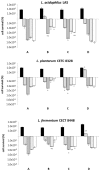Barley β-glucans-containing food enhances probiotic performances of beneficial bacteria
- PMID: 24562330
- PMCID: PMC3958897
- DOI: 10.3390/ijms15023025
Barley β-glucans-containing food enhances probiotic performances of beneficial bacteria
Abstract
Currently, the majority of prebiotics in the market are derived from non-digestible oligosaccharides. Very few studies have focused on non-digestible long chain complex polysaccharides in relation to their potential as novel prebiotics. Cereals β-glucans have been investigated for immune-modulating properties and beneficial effects on obesity, cardiovascular diseases, diabetes, and cholesterol levels. Moreover, β-glucans have been reported to be highly fermentable by the intestinal microbiota in the caecum and colon, and can enhance both growth rate and lactic acid production of microbes isolated from the human intestine. In this work, we report the effects of food matrices containing barley β-glucans on growth and probiotic features of four Lactobacillus strains. Such matrices were able to improve the growth rate of the tested bacteria both in unstressed conditions and, importantly, after exposure to in vitro simulation of the digestive tract. Moreover, the effect of β-glucans-containing food on bacterial adhesion to enterocyte-like cells was analyzed and a positive influence on probiotic-enterocyte interaction was observed.
Figures


 and pH 3.0
and pH 3.0
 ), and intestinal (small
), and intestinal (small
 and large intestine □) stresses conveying microorganisms in saline solution (negative control) and three different food matrices (not-enriched pasta; β-glucans enriched pasta; barley flour). Values represent mean ± standard deviation of three different experiments. Statistical analysis was carried out by Student’s t-test (* p < 0.05 and ** p < 0.005) and significant differences are relative to OGI transit using saline solution as a carrier. Cell survival is expressed as a percentage (in logarithmic scale) relative to the untreated control sample (1.00 × 102 corresponds to 100%, 1.00 × 106 corresponds to 0.000001%).
and large intestine □) stresses conveying microorganisms in saline solution (negative control) and three different food matrices (not-enriched pasta; β-glucans enriched pasta; barley flour). Values represent mean ± standard deviation of three different experiments. Statistical analysis was carried out by Student’s t-test (* p < 0.05 and ** p < 0.005) and significant differences are relative to OGI transit using saline solution as a carrier. Cell survival is expressed as a percentage (in logarithmic scale) relative to the untreated control sample (1.00 × 102 corresponds to 100%, 1.00 × 106 corresponds to 0.000001%).

Similar articles
-
Barley-based probiotic food mixture: health effects and future prospects.Crit Rev Food Sci Nutr. 2022;62(29):7961-7975. doi: 10.1080/10408398.2021.1921692. Epub 2021 May 17. Crit Rev Food Sci Nutr. 2022. PMID: 33998934 Review.
-
Beta-glucans improve growth, viability and colonization of probiotic microorganisms.Int J Mol Sci. 2012;13(5):6026-6039. doi: 10.3390/ijms13056026. Epub 2012 May 18. Int J Mol Sci. 2012. PMID: 22754347 Free PMC article.
-
In Situ β-Glucan Fortification of Cereal-Based Matrices by Pediococcus parvulus 2.6: Technological Aspects and Prebiotic Potential.Int J Mol Sci. 2017 Jul 21;18(7):1588. doi: 10.3390/ijms18071588. Int J Mol Sci. 2017. PMID: 28754020 Free PMC article.
-
Application of cereals and cereal components in functional foods: a review.Int J Food Microbiol. 2002 Nov 15;79(1-2):131-41. doi: 10.1016/s0168-1605(02)00187-3. Int J Food Microbiol. 2002. PMID: 12382693 Review.
-
Growth studies of potentially probiotic lactic acid bacteria in cereal-based substrates.J Appl Microbiol. 2002;92(5):851-9. doi: 10.1046/j.1365-2672.2002.01592.x. J Appl Microbiol. 2002. PMID: 11972688
Cited by
-
The Use of Lactic Acid Bacteria Starter Cultures during the Processing of Fermented Cereal-based Foods in West Africa: A Review.Trop Life Sci Res. 2014 Dec;25(2):81-100. Trop Life Sci Res. 2014. PMID: 27073601 Free PMC article.
-
The Effect of Tomatine on Gene Expression and Cell Monolayer Integrity in Caco-2.Molecules. 2018 Mar 13;23(3):644. doi: 10.3390/molecules23030644. Molecules. 2018. PMID: 29533987 Free PMC article.
-
Fresh-cut pineapple as a new carrier of probiotic lactic acid bacteria.Biomed Res Int. 2014;2014:309183. doi: 10.1155/2014/309183. Epub 2014 Jun 29. Biomed Res Int. 2014. PMID: 25093163 Free PMC article.
-
Classification of the Occurrence of Dyslipidemia Based on Gut Bacteria Related to Barley Intake.Front Nutr. 2022 Mar 24;9:812469. doi: 10.3389/fnut.2022.812469. eCollection 2022. Front Nutr. 2022. PMID: 35399681 Free PMC article.
-
Whole Grain Qingke Attenuates High-Fat Diet-Induced Obesity in Mice With Alterations in Gut Microbiota and Metabolite Profile.Front Nutr. 2021 Dec 7;8:761727. doi: 10.3389/fnut.2021.761727. eCollection 2021. Front Nutr. 2021. PMID: 34950689 Free PMC article.
References
-
- Lam K.L., Cheung C.K. Non-digestible long chainbeta-glucans as novel prebiotics. Bioact. Carbohydr. Diet. Fibers. 2013;2:45–64.
-
- Collado M.C., Isolauri E., Salminen S., Sanz Y. The impact of probiotic on gut health. Curr. Drug Metab. 2009;10:68–78. - PubMed
-
- Schrezenmeir J., de Vrese M. Probiotics, prebiotics, and synbiotics-approaching a definition. Am. J. Clin. Nutr. 2001;73:361S–364S. - PubMed
-
- Food and Agriculture Organization of United Nations and World Health Organization Working Group (FAO/WHO) Guidelines for the Evaluation of Probiotics in Food. Technical report for FAO/WHO; London, UK: 2002.
-
- Vasilijevic T., Shah N.P. Handbook of Food Products Manufacturing. Vol. 2. John Wiley & Sons, Inc; Hoboken, NJ, USA: 2007. Fermented Milk: Health Benefits beyond Probiotic Effect; pp. 99–116.
Publication types
MeSH terms
Substances
LinkOut - more resources
Full Text Sources
Other Literature Sources

